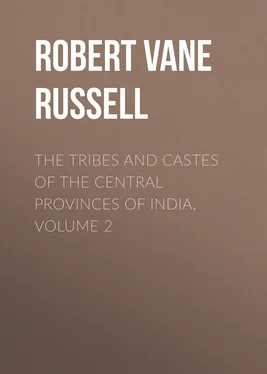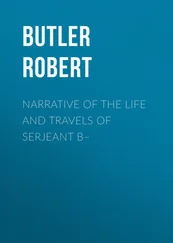Robert Vane Russell - The Tribes and Castes of the Central Provinces of India, Volume 2
Здесь есть возможность читать онлайн «Robert Vane Russell - The Tribes and Castes of the Central Provinces of India, Volume 2» — ознакомительный отрывок электронной книги совершенно бесплатно, а после прочтения отрывка купить полную версию. В некоторых случаях можно слушать аудио, скачать через торрент в формате fb2 и присутствует краткое содержание. Жанр: foreign_prose, История, foreign_edu, foreign_antique, на английском языке. Описание произведения, (предисловие) а так же отзывы посетителей доступны на портале библиотеки ЛибКат.
- Название:The Tribes and Castes of the Central Provinces of India, Volume 2
- Автор:
- Жанр:
- Год:неизвестен
- ISBN:нет данных
- Рейтинг книги:4 / 5. Голосов: 1
-
Избранное:Добавить в избранное
- Отзывы:
-
Ваша оценка:
- 80
- 1
- 2
- 3
- 4
- 5
The Tribes and Castes of the Central Provinces of India, Volume 2: краткое содержание, описание и аннотация
Предлагаем к чтению аннотацию, описание, краткое содержание или предисловие (зависит от того, что написал сам автор книги «The Tribes and Castes of the Central Provinces of India, Volume 2»). Если вы не нашли необходимую информацию о книге — напишите в комментариях, мы постараемся отыскать её.
The Tribes and Castes of the Central Provinces of India, Volume 2 — читать онлайн ознакомительный отрывок
Ниже представлен текст книги, разбитый по страницам. Система сохранения места последней прочитанной страницы, позволяет с удобством читать онлайн бесплатно книгу «The Tribes and Castes of the Central Provinces of India, Volume 2», без необходимости каждый раз заново искать на чём Вы остановились. Поставьте закладку, и сможете в любой момент перейти на страницу, на которой закончили чтение.
Интервал:
Закладка:
Baiga village, Bālāghāt District.
8. Dress and food.
Their dress is of the most simple description, a small strip of rag between the legs and another wisp for a head-covering sufficing for the men, though the women are decently covered from their shoulders to half-way between the thighs and knees. A Baiga may be known by his scanty clothing and tangled hair, and his wife by the way in which her single garment is arranged so as to provide a safe sitting-place in it for her child. Baiga women have been seen at work in the field transplanting rice with babies comfortably seated in their cloth, one sometimes supported on either hip with their arms and legs out, while the mother was stooping low, hour after hour, handling the rice plants. A girl is tattooed on the forehead at the age of five, and over her whole body before she is married, both for the sake of ornament and because the practice is considered beneficial to the health. The Baigas are usually without blankets or warm clothing, and in the cold season they sleep round a wood fire kept burning or smouldering all night, stray sparks from which may alight on their tough skins without being felt. Mr. Lampard relates that on one occasion a number of Baiga men were supplied by the Mission under his charge with large new cloths to cover their bodies with and make them presentable on appearance in church. On the second Sunday, however, they came with their cloths burnt full of small holes; and they explained that the damage had been done at night while they were sleeping round the fire.
A Baiga, Mr. Lampard continues, is speedily discerned in a forest village bazār, and is the most interesting object in it. His almost nude figure, wild, tangled hair innocent of such inventions as brush or comb, lithe wiry limbs and jungly and uncivilised appearance, mark him out at once. He generally brings a few mats or baskets which he has made, or fruits, roots, honey, horns of animals, or other jungle products which he has collected, for sale, and with the sum obtained (a few pice or annas at the most) he proceeds to make his weekly purchases, changing his pice into cowrie shells, of which he receives eighty for each one. He buys tobacco, salt, chillies and other sundries, besides as much of kodon, kutki, or perhaps rice, as he can afford, always leaving a trifle to be expended at the liquor shop before departing for home. The various purchases are tied up in the corners of the bit of rag twisted round his head. Unlike pieces of cloth known to civilisation, which usually have four corners, the Baiga’s headgear appears to be nothing but corners, and when the shopping is done the strip of rag may have a dozen minute bundles tied up in it.
In Baihar of Bālāghāt buying and selling are conducted on perhaps the most minute scale known, and if a Baiga has one or two pice 97 97 Farthings.
to lay out he will spend no inconsiderable time over it. Grain is sold in small measures holding about four ounces called baraiyas , but each of these has a layer of mud at the bottom of varying degrees of thickness, so as to reduce its capacity. Before a purchase can be made it must be settled by whose baraiya the grain is to be measured, and the seller and purchaser each refuse the other’s as being unfair to himself, until at length after discussion some neutral person’s baraiya is selected as a compromise. Their food consists largely of forest fruits and roots with a scanty allowance of rice or the light millets, and they can go without nourishment for periods which appear extraordinary to civilised man. They eat the flesh of almost all animals, though the more civilised abjure beef and monkeys. They will take food from a Gond but not from a Brāhman. The Baiga dearly loves the common country liquor made from the mahua flower, and this is consumed as largely as funds will permit of at weddings, funerals and other social gatherings, and also if obtainable at other times. They have a tribal panchāyat or committee which imposes penalties for social offences, one punishment being the abstention from meat for a fixed period. A girl going wrong with a man of the caste is punished by a fine, but cases of unchastity among unmarried Baiga girls are rare. Among their pastimes dancing is one of the chief, and in their favourite dance, known as karma , the men and women form long lines opposite to each other with the musicians between them. One of the instruments, a drum called māndar , gives out a deep bass note which can be heard for miles. The two lines advance and retire, everybody singing at the same time, and when the dancers get fully into the time and swing, the pace increases, the drums beat furiously, the voices of the singers rise higher and higher, and by the light of the bonfires which are kept burning the whole scene is wild in the extreme.
9. Occupation.
The Baigas formerly practised only shifting cultivation, burning down patches of jungle and sowing seed on the ground fertilised by the ashes after the breaking of the rains. Now that this method has been prohibited in Government forest, attempts have been made to train them to regular cultivation, but with indifferent success in Bālāghāt. An idea of the difficulties to be encountered may be obtained from the fact that in some villages the Baiga cultivators, if left unwatched, would dig up the grain which they had themselves sown as seed in their fields and eat it; while the plough-cattle which were given to them invariably developed diseases in spite of all precautions, as a result of which they found their way sooner or later to the Baiga’s cooking-pot. But they are gradually adopting settled habits, and in Mandla, where a considerable block of forest was allotted to them in which they might continue their destructive practice of shifting sowings, it is reported that the majority have now become regular cultivators. One explanation of their refusal to till the ground is that they consider it a sin to lacerate the breast of their mother earth with a ploughshare. They also say that God made the jungle to produce everything necessary for the sustenance of men and made the Baigas kings of the forest, giving them wisdom to discover the things provided for them. To Gonds and others who had not this knowledge, the inferior occupation of tilling the land was left. The men never become farmservants, but during the cultivating season they work for hire at uprooting the rice seedlings for transplantation; they do no other agricultural labour for others. Women do the actual transplantation of rice and work as harvesters. The men make bamboo mats and baskets, which they sell in the village weekly markets. They also collect and sell honey and other forest products, and are most expert at all work that can be done with an axe, making excellent woodcutters. But they show no aptitude in acquiring the use of any other implement, and dislike steady continuous labour, preferring to do a few days’ work and then rest in their homes for a like period before beginning again. Their skill and dexterity in the use of the axe in hunting is extraordinary. Small deer, hares and peacocks are often knocked over by throwing it at them, and panthers and other large animals are occasionally killed with a single blow. If one of two Baigas is carried off by a tiger, the survivor will almost always make a determined and often successful attempt to rescue him with nothing more formidable than an axe or a stick. They are expert trackers, and are also clever at setting traps and snares, while, like Korkus, they catch fish by damming streams in the hot weather and throwing into the pool thus formed some leaf or root which stupefies them. Even in a famine year, Mr. Low says, a Baiga can collect a large basketful of roots in a single day; and if the bamboo seeds he is amply provided for. Nowadays Baiga cultivators may occasionally be met with who have taken to regular cultivation and become quite prosperous, owning a number of cattle.
Читать дальшеИнтервал:
Закладка:
Похожие книги на «The Tribes and Castes of the Central Provinces of India, Volume 2»
Представляем Вашему вниманию похожие книги на «The Tribes and Castes of the Central Provinces of India, Volume 2» списком для выбора. Мы отобрали схожую по названию и смыслу литературу в надежде предоставить читателям больше вариантов отыскать новые, интересные, ещё непрочитанные произведения.
Обсуждение, отзывы о книге «The Tribes and Castes of the Central Provinces of India, Volume 2» и просто собственные мнения читателей. Оставьте ваши комментарии, напишите, что Вы думаете о произведении, его смысле или главных героях. Укажите что конкретно понравилось, а что нет, и почему Вы так считаете.












